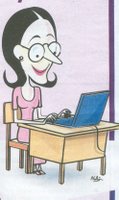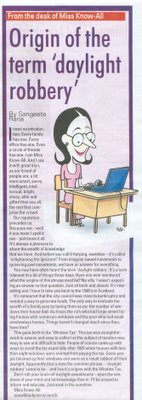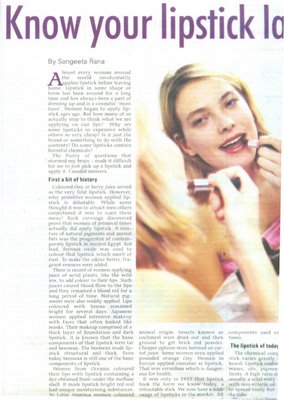(Published on 18 April 2006 in 'Women at Work' - W @ W - a supplement of the Daily Mirror, Colombo, Sri Lanka)
Almost every woman around the world involuntarily applies lipstick before leaving home. Lipstick in some shape or form has been around for a long time and has always been a part of dressing up and is a cosmetic ‘must have’. Women began to apply lipstick ages ago. But how many of us actually stop to think what we are applying on our lips? Why are some lipsticks so expensive while others so very cheap? Is it just the brand or something to do with the contents? Do some lipsticks contain harmful chemicals?
The flurry of questions that stormed my brain – made it difficult for me to just pick up a lipstick and apply it. I needed answers.
First a bit of history
Coloured clay or berry juice served as the very first lipstick. However, why primitive women applied lipstick is debatable. While some thought it was to attract men others conjectured it was to scare them away! Rock carvings discovered prove that women of primeval times actually did apply lipstick. A mixture of natural pigments and animal fats was the progenitor of contemporary lipstick in Ancient Egypt. Red lead, ferrous oxide was used to colour that lipstick which smelt of rust. To make the odour better, fragrant essences were added.
There is record of women applying juice of acrid plants, like the wild iris, to add colour to their lips. Such juices caused blood flow to the lips and they remained a blood red for a long period of time. Natural pigments were also widely applied. Lips coloured with henna remained bright for several days. Japanese women applied intensive makeup with faces that often looked like masks. Their makeup comprised of a thick layer of foundation and dark lipstick. It is known that the basic components of that lipstick were tar and beeswax. The beeswax made lipstick structural and thick. Even today beeswax is still one of the basic components of lipstick.
Women from Oceania coloured their lips with lipstick containing a dye obtained from under the mollusc shell. It made lipstick bright red and had unique moisturising substances. In Latin America women coloured lips with carmine, another dye of animal origin. Insects known as cochineal were dried out and then ground to get brick red powder. Cheaper options were beetroot or carrot juice. Some women even applied pounded orange clay. Women in Europe applied cinnabar as lipstick. That was vermilion which is dangerous for health.
It was only in 1915 that lipstick took the form we know today, a retractable stick. We now have a wide range of lipsticks in the market. All of them are improved versions of components used earlier in olden times.
The lipstick of today – the base
The chemical composition of lipstick varies greatly from brand to brand. Lipstick contains a variety of waxes, oils, pigments, and emollients. A high ratio of the lipstick is usually a solid waxy material mixed with non-volatile oil. This enables it to spread easily but remain stiff in the tube.
The wax gives lipstick its shape and ease of application. Among the waxes are beeswax, a substance obtained from bee honeycombs that consists of esters of monohydric alcohols and straight-chain acids. Other waxes include carnauba wax, obtained from the wax palm trees, and candelilla wax, which in turn is obtained from the plant Euphorbia antisyphilitica. The plant is immersed in boiling water containing sulphuric acid and the wax that rises to the surface is then skimmed off. A recently patented composition uses a solid silicone material with polyethylene solidifier, and silicone oil.
The oils and fats used in lipstick include olive oil, mineral oil, castor oil, cocoa butter, and lanolin. Majority of the lipstick brands contain substantial amounts of castor oil. It forms a tough, shiny film when it dries after application. In recent years, ingredients such as moisturisers, vitamin E, aloe vera, collagen, amino acids, and sunscreen have been added to lipstick. The extra components keep lips soft, moist, and protected from the sun and dryness. Ingredients added insure that the lipstick has the proper texture and melting point. Esters of fatty acids are sometimes added to give the lipstick 'stickiness'.
The lipstick of today – the colour
A lipstick gets its colour from a variety of added pigments. The dyes have to be insoluble in water, so the colour will last. Soluble dyes are first converted to insoluble particles by treatment with metal oxides. Eosin is a commonly used red dye.
Among other pigments used are bromo acid and insoluble dyes known as lakes. Pink shades are made by mixing titanium dioxide with various shades of red. Manufacturing lipstick is similar to making crayons. The process involves heating, mixing and stirring. Oils and lanolin are added for specific formula requirements. The hot liquid is poured into cold metal moulds where it solidifies and is then chilled. The formed lipstick is put through a flame for a split second to create a smooth and glossy finish.
Today we have a wide range of lipsticks. The customer has an array of products to choose from: frosted, mattes, sheers, stains, and long-lasting colour.
eFrosted lipsticks include an agent, often a bismuth compound that adds lustre to the colour. Bismuth ox chloride, which is synthetic pearl, imparts a frost or shine. Bismuth sub carbonate is used as a skin protective. Most bismuth compounds used in cosmetics are not toxic when ingested, but they may cause allergic reactions when applied to the skin.
eMatte lipsticks are heavy in wax and pigment but lighter in emollients. They have more texture than shine.
eCrèmes are a balance of shine and texture.
eGlosses have a high shine but are low in colour.
eSheers and stains contain a lot of oil and a medium amount of wax with a spot of colour.
eShimmers have extra glimmer, which comes from mica or silica particles.
eLong-lasting colour lipsticks contain silicone oil, which sticks down the colour to your lips.
eLip gloss usually comes in jars and contains different proportions of the same ingredients as lipstick but usually has less wax and more oil to make the lips shinier.
The flood of information had me stumped. Until today, I had never thought of reading the label on a lipstick or asking the assistant at the store for details. I am a convert now. I am not going to just walk into a store and pick a lipstick at random because I like the colour. I'm going to read every lipstick label before I purchase it.
Know your lipstick lady. I now know mine!










